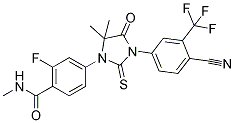All AbMole products are for research use only, cannot be used for human consumption.

MDV3100 is an orally bioavailable, organic, non-steroidal small molecule targeting the androgen receptor (AR) with potential antineoplastic activity. MDV3100 (Enzalutamide) blocks androgens from binding to the androgen receptor and prevents nuclear translocation and co-activator recruitment of the ligand-receptor complex. It also induces tumour cell apoptosis, and has no agonist activity. Early preclinical studies also suggest that MDV3100 inhibits breast cancer cell growth.

Int J Biol Sci. 2025 Apr 09;21(6):2843-2863.
VAV2 exists in extrachromosomal circular DNA and contributes Enzalutamide resistance of prostate cancer via stabilization of AR/ARv7
MDV3100 purchased from AbMole

Nucleic Acids Res. 2023 Feb 2;gkad043.
SMAD3 promotes expression and activity of the androgen receptor in prostate cancer
MDV3100 purchased from AbMole
| Cell Experiment | |
|---|---|
| Cell lines | VCaP cell line |
| Preparation method | Proliferation assays Trypsinized VCaP cells were adjusted to a concentration of 100,000 cells per mL in phenol-red-free RPMI 1640 (with 5% CSS), and dispensed in 16 µL aliquots into CellBIND 384 well plates (Corning, Lowell, MA). Cells were incubated for 48 hours, after which ligand was added in a 16 µL volume to the RPMI culture medium. For the antagonist mode assay, the ligands were diluted in culture medium also containing 30 pM R1881 (final [R1881] = 15 pM). After 7 days’ incubation, 16 µL of CellTiter-Glo Luminescent Cell Viability Assay (Promega, Madison, WI) was added and Relative Luminescence Units (RLUs) measured. In the agonist mode assay, percent viability of the samples was calculated as: % viability=[RLU sample-RLU medium without cells]/[RLU DMSO treated cells-RLU medium without cells]. In the antagonist mode assay, the percent viability of the samples was calculated as: % viability=[RLU sample-RLU VCaP without R1881]/[RLU R1881-treated cells - RLU VCaP without R1881]. |
| Concentrations | 0~10µM |
| Incubation time | 48h |
| Animal Experiment | |
|---|---|
| Animal models | LNCaP/AR(cs) xenograft model in mice |
| Formulation | prepared in 18% PEG-400, 1% Tween-80 and 1% povidone, and were formulated for dosing in 15% Vitamin E-TPGS and 65% of a 0.5% w/v CMC solution in 20 mM citrate buffer (pH 4.0). |
| Dosages | 100mg/kg |
| Administration | oral gavage |
| Molecular Weight | 464.44 |
| Formula | C21H16F4N4O2S |
| CAS Number | 915087-33-1 |
| Solubility (25°C) | DMSO 50 mg/mL |
| Storage |
Powder -20°C 3 years ; 4°C 2 years In solvent -80°C 6 months ; -20°C 1 month |
| Related Androgen Receptor Products |
|---|
| LGD-3303
LGD-3303 is a nonsteroidal, nonaromatizable selective androgen receptor ligand that binds to the androgen receptor with high affinity in a radiolabeled to competitive binding assay (Ki=0.9 nM). |
| Ar-V7-IN-1
Ar-V7-IN-1 is a potent inhibitor of Ar-V7. AR-V7 is a hormone-independent splice variant of the androgen receptor. Ar-V7-IN-1 has the potential for the research of various indications such as prostate cancer. |
| SC912
SC912 is a potent and selective AR-V7 inhibitor with IC50 of 0.36 μM. SC912 binds directly to AR-FL and AR-V7 proteins, inhibites nuclear localization and chromatin binding capabilities. SC912 exerts anticancer activity through inhibition of proliferation, induction of cell cycle arrest and apoptosis. |
| A4B17
A4B17 is an androgen receptor N-terminal inhibitor, which can be used for the research of androgen-responsive prostate cancer. |
| AZ'3137
AZ‘3137 is an orally active PROTAC-type androgen receptor (AR) degrader, with a DC50 value of 22 nM. |
All AbMole products are for research use only, cannot be used for human consumption or veterinary use. We do not provide products or services to individuals. Please comply with the intended use and do not use AbMole products for any other purpose.


Products are for research use only. Not for human use. We do not sell to patients.
© Copyright 2010-2024 AbMole BioScience. All Rights Reserved.
